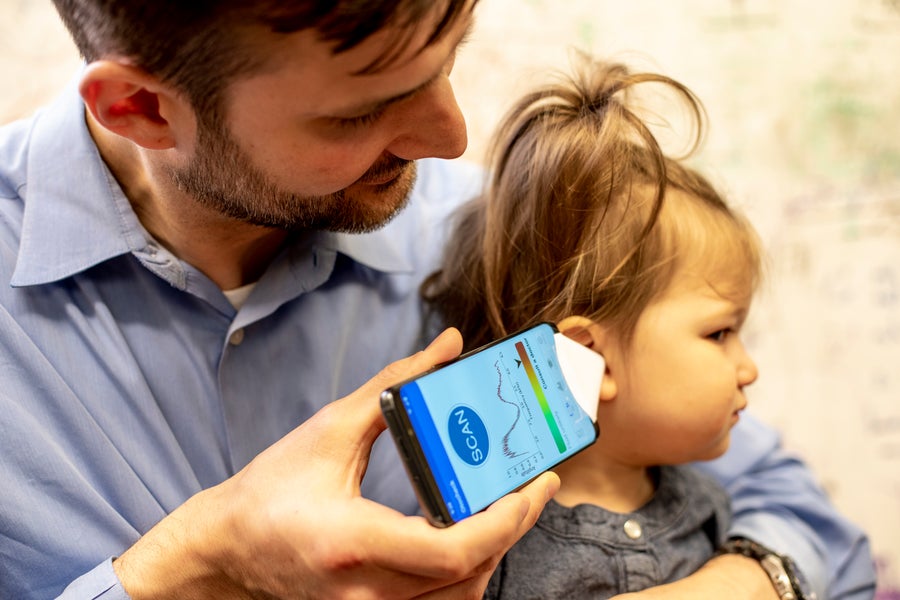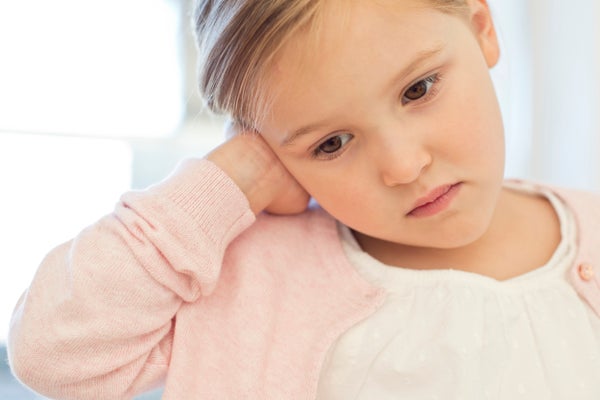By the time they reach school age, about 90 percent of children will have experienced a condition in which fluid fills the middle ear, muffling sound and sometimes triggering infection. Diagnosis usually requires a visit to a specialist—but researchers have now developed an app that detects this fluid just as accurately, with only a smartphone and a paper funnel.
“Based on the size of the problem, we really wanted to design a technology that could detect it accurately, and also be accessible to a wide audience,” says Justin Chan, a doctoral student at the Paul G. Allen School for Computer Science & Engineering at the University of Washington. Chan is lead author on a new study that tested the app, published this week in Science Translational Medicine.
The fluid usually clears on its own, but if not, it can lead to a painful ear infection called acute otitis media. And in some cases the fluid can persist for more than a year, causing hearing loss during this period. If this happens when children are learning to speak, it can slow their development of language and social skills.
On supporting science journalism
If you're enjoying this article, consider supporting our award-winning journalism by subscribing. By purchasing a subscription you are helping to ensure the future of impactful stories about the discoveries and ideas shaping our world today.

Dr. Randall Bly, an assistant professor of otolaryngology-head and neck surgery at the UW School of Medicine who practices at Seattle Children's Hospital, uses the app and funnel to check his daughter's ear. Credit: Dennis Wise University of Washington
Doctors typically detect the problem by peering into the ear for a visual assessment. Yet Chan says this method has only a 50 percent accuracy rate. “Right now, if you bring your child to a pediatrician, or to any urgent care family doctor, the way they look at whether or not there's fluid in the middle ear is by looking at the eardrum,” says co-author Sharat Raju, resident surgeon in the department of head and neck surgery at the University of Washington. “It’s a really difficult visual assessment—some studies have shown pretty low accuracy rates for detection. The best way to know whether or not there’s fluid is really an assessment of mobility of the eardrum.” More accurate diagnosis requires testing by specialists.
For a cheaper and more accessible alternative, researchers at the University of Washington turned to smartphones. First the user follows a template to cut and tape a piece of paper into a funnel, which can be placed between a smartphone and the patient’s ear. Next the app plays a chirping sound through the phone’s speaker; the sound waves bounce off the eardrum and hit the phone’s microphone, where they register and are analyzed by the app. An eardrum with fluid behind it will vibrate differently than if the middle ear is full of air, as it normally is.
To develop the app, the researchers first played chirps for patients with and without fluid in their ears. They recorded the echoes, which indicate the eardrum’s mobility. Then they used a machine learning model to classify the returning sound waves, determining which audio characteristics indicated a normal ear and which suggested the presence of fluid. Once they had trained the app they tested it on 98 children, ranging from 18 months to 17 years old, at Seattle Children’s Hospital. The app correctly detected fluid in 85 percent of cases, and correctly identified fluid-free ears in 82 percent. “It's right on par with the best diagnostic techniques that we have available in clinic,” Raju says. Parents tried the app on 25 of the subjects, and performed the test as effectively as physicians.
The researchers are currently trying to get FDA approval for the app, and have founded a company to commercialize it; they hope to make it available by the end of the year, to help parents track children’s ear health at home. For example, it might confirm that a child’s fever and ear-tugging is caused by an ear infection, as opposed to another illness. It could be even more helpful for a patient whose middle ear remains stubbornly fluid-filled for a long time. If a child has this problem for more than three months, physicians typically recommend surgery to implant a small drainage tube in the eardrum.
“Classically, what happens now is folks come in and are monitored over time for resolution of that ear fluid,” says Jennifer Shin, vice chair for academic affairs at Harvard Medical School and a surgeon in the department of otolaryngology, who was not involved in the new study. But if the new app works out, parents could possibly avoid multiple visits to the doctor. “Kids who can clear their fluid despite having recurrent acute otitis media may not necessarily need to undergo surgery,” Shin notes. “Having more information via smartphone—that families can use to help think about decisions and give clinicians more information—can really help over time.”
In addition to home use, Chan suggests the app could empower physicians who lack the resources to perform traditional ear exams. “Smartphones are ubiquitous,” he says. “If a doctor in a developing country has access to smartphones, they can basically have access to specialist-level accuracies.”
